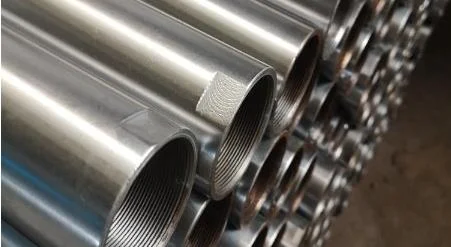Longitudinal Welded Pipe
Longitudinal welded pipe is one of the welded pipes. Due to different production processes, longitudinal welded pipes can be divided into high-frequency longitudinal welded pipes and submerged arc welded longitudinal welded pipes(LSAW steel pipes). Submerged arc welded longitudinal welded pipes are divided into UOE, RBE, and JCOE steel pipes according to their different forming methods.

Production process of longitudinal welded pipe
Longitudinal welded pipes can be divided into high-frequency longitudinal welded pipes and submerged arc welded longitudinal welded pipes according to the production process. Submerged arc welded longitudinal welded pipes are divided into UOE, RBE, JCOE steel pipes, etc. according to their different forming methods. The following describes the most common high-frequency longitudinal welded pipe and submerged arc welded straight seam steel forming process.
Submerged arc welding process
1. Plate inspection: After the steel plate used to manufacture large-diameter submerged arc welded longitudinal welded pipe enters the production line, the whole plate is first subjected to ultrasonic inspection;
2. Edge milling: double-sided milling of the two edges of the steel plate by an edge milling machine to achieve the required plate width, plate edge parallelism and bevel shape;
3. Pre-bending: Use a pre-bending machine to pre-bend the edge of the board, so that the edge of the board has a curvature that meets the requirements;
4. Forming: On the JCO forming machine, first half of the pre-bent steel plate is pressed into a "J" shape by multiple stepping and pressing, and then the other half of the steel plate is also bent and pressed into a "C" shape, and finally an opening is formed "O" shape
5. Pre-welding: Join the formed longitudinally welded steel pipes and use gas shielded welding (MAG) for continuous welding;
6. Internal welding: adopt longitudinal multi-wire submerged arc welding (up to four wires) to weld on the inner side of the longitudinal welded pipe;
7. External welding: use longitudinal multi-wire submerged arc welding to weld on the outside of the longitudinal submerged arc welded steel pipe;
8. Ultrasonic inspection I: 100% inspection of the inner and outer welds of the longitudinally welded steel pipe and the base materials on both sides of the weld;
9. X-ray inspection I: 100% X-ray industrial television inspection of the inner and outer welds, using an image processing system to ensure the sensitivity of flaw detection;
10. Diameter expansion: expand the total length of the submerged arc welded longitudinal welded pipe to improve the dimensional accuracy of the steel pipe and improve the distribution of the internal stress of the steel pipe;
11. Hydraulic test: The expanded steel pipes are inspected one by one on the hydraulic testing machine to ensure that the steel pipe meets the test pressure required by the standard. The machine has automatic recording and storage functions;
12. Chamfering: Process the pipe end of the steel pipe that has passed the inspection to meet the required pipe end groove size;
13. Ultrasonic inspection Ⅱ: Perform ultrasonic inspection again one by one to check the possible defects of the longitudinally welded steel pipe after diameter expansion and water pressure;
14. X-ray inspection Ⅱ: X-ray industrial television inspection and filming of pipe end welds on steel pipes after expansion and hydraulic test;
15. Tube end magnetic particle inspection: carry out this inspection to find tube end defects;
16. Anti-corrosion and coating: Qualified steel pipes are anti-corrosion and coating according to user requirements.
Advantages and disadvantages of longitudinal welded pipes
longitudinal welded pipe is a welding process of steel pipe opposite to spiral steel pipe. Because the welding process of this kind of steel pipe is relatively simple, and the welding cost is relatively low, it can achieve higher efficiency in production, so it is relatively common on the market. And it is a widely used product.
This kind of steel pipe is welded by a welding method parallel to the longitudinal direction of the steel pipe. With the same diameter and length, the welded length of longitudinal welded pipes is much less, while the welded length of spiral steel pipes may increase by more than 30%.
During welding, due to technological reasons, the efficiency is relatively low, and the output is also quite low. But the same blank, generally spiral welded pipe can get products of various diameters. In contrast, longitudinal welded pipes cannot achieve this welding effect.
Because the cost of the process used in welding is relatively low, and the manufacturing processes of forging steel, extrusion, rolling and drawing steel can all be manufactured, and the specifications are also determined, it provides a wide range of applications possibility.
Application of longitudinal welded pipe
1. Straight-seam steel pipes are mainly used in water supply engineering, petrochemical, chemical, electric power, agricultural irrigation and urban construction.
2. Liquid transportation: water supply and drainage.
3. Gas transportation: natural gas, steam, liquefied petroleum gas.
4. Structural use: used for piling pipes and bridges; used for docks, roads, building structures, etc.






